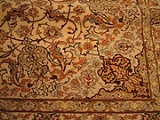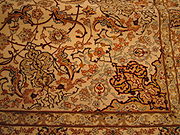
Isfahan rug
Encyclopedia
The Iran
ian city of Isfahan
(also spelt Esfahan) has long been one of the centres for production of the famous Persian Rug
.
Weaving in Isfahan flourished in the Safavid era. But when the Afghans invaded Iran
, ending the Safavid dynasty, the craft also became stagnant.
Not until 1920s, between two world wars, was weaving again taken seriously by the people of Isfahan. They started to weave Safavid designs and once again became one of the most important nexus of the Iranian rug weaving industry. Isfahani carpets today are among the most wanted in world markets, having many customers in western countries.
Isfahani rugs and carpets usually have ivory backgrounds with blue, rose, and indigo motifs. Isfahani rugs and carpets often have very symmetrical and balanced designs. They usually have a single medallion that is surrounded with vines and palmettos. These rugs and carpets usually have excellent quality. The most famous master weaver in Isfahan is Seirafian.
The city of Isfahan (Eşfahan) is now a world heritage site and produces what are arguably the most consistently fine wool pile rugs made anywhere in the world today. Their quality may be matched by individual items from the other major Persian workshop groups, but Isfahan produces far fewer poor quality rugs.
 Isfahan rugs are knotted on either silk or cotton foundations, with up to 400 Persian knots per in2, using exceptionally good quality (often Kurk) wool for the pile, which is normally clipped quite low. In contemporary items the palette is normally more pastel, and technical perfection is generally of greater importance than artistic flair. Contemporary Isfahans are however extremely attractive, and the subduing of the palette, particularly the elimination of strong reds, makes them more compatible with Western decorative schemes.
Isfahan rugs are knotted on either silk or cotton foundations, with up to 400 Persian knots per in2, using exceptionally good quality (often Kurk) wool for the pile, which is normally clipped quite low. In contemporary items the palette is normally more pastel, and technical perfection is generally of greater importance than artistic flair. Contemporary Isfahans are however extremely attractive, and the subduing of the palette, particularly the elimination of strong reds, makes them more compatible with Western decorative schemes.
A range of traditional designs are still used including allover Shah Abbas, vase, Tree of Life and pictorial schemes but by far the most popular composition is based on a circular central medallion (derived from the famous mosque of Shah Lutf Allah in Esfahan) set against an elegantly sculpted field decorated with intricately purling vine palmette and floral motifs.
The most famous name in Isfahan rugs is that of the late Haj Agha Reza Seirafian and his seven sons Mohammad Ali, Mohammad, The Late Mohammad Sadegh, Ahmad, Ali, The Late Hossien, Mohammad Hassan,And his first grandson Mojtaba Seirafian. But Isfahan is more than just the Seirafians, noted masters include the great Master Ahmad Archang, whose work is currently being exhibited in the National Rugs Museum in Tehran, Master Faizollah Haghighi, as well as Dardahsti and the Majnoonies (Hekmat Nejad family). Emami, Shahpour Enteshari are also master weavers of note.
. They were commissioned by wealthy Polish noblemen
and decorated with their coats of arms. Some of them were later resold to West European buyers who were often convinced of their Polish origin, hence their name.
Iran
Iran , officially the Islamic Republic of Iran , is a country in Southern and Western Asia. The name "Iran" has been in use natively since the Sassanian era and came into use internationally in 1935, before which the country was known to the Western world as Persia...
ian city of Isfahan
Isfahan (city)
Isfahan , historically also rendered in English as Ispahan, Sepahan or Hispahan, is the capital of Isfahan Province in Iran, located about 340 km south of Tehran. It has a population of 1,583,609, Iran's third largest city after Tehran and Mashhad...
(also spelt Esfahan) has long been one of the centres for production of the famous Persian Rug
Persian rug
The Persian carpet is an essential part of Persian art and culture. Carpet-weaving is undoubtedly one of the most distinguished manifestations of Persian culture and art, and dates back to ancient Persia. In 2008, Iran’s exports of hand-woven carpets was $420 million or 30% of the world's market...
.
Weaving in Isfahan flourished in the Safavid era. But when the Afghans invaded Iran
Iran
Iran , officially the Islamic Republic of Iran , is a country in Southern and Western Asia. The name "Iran" has been in use natively since the Sassanian era and came into use internationally in 1935, before which the country was known to the Western world as Persia...
, ending the Safavid dynasty, the craft also became stagnant.
Not until 1920s, between two world wars, was weaving again taken seriously by the people of Isfahan. They started to weave Safavid designs and once again became one of the most important nexus of the Iranian rug weaving industry. Isfahani carpets today are among the most wanted in world markets, having many customers in western countries.
Isfahani rugs and carpets usually have ivory backgrounds with blue, rose, and indigo motifs. Isfahani rugs and carpets often have very symmetrical and balanced designs. They usually have a single medallion that is surrounded with vines and palmettos. These rugs and carpets usually have excellent quality. The most famous master weaver in Isfahan is Seirafian.
The city of Isfahan (Eşfahan) is now a world heritage site and produces what are arguably the most consistently fine wool pile rugs made anywhere in the world today. Their quality may be matched by individual items from the other major Persian workshop groups, but Isfahan produces far fewer poor quality rugs.

A range of traditional designs are still used including allover Shah Abbas, vase, Tree of Life and pictorial schemes but by far the most popular composition is based on a circular central medallion (derived from the famous mosque of Shah Lutf Allah in Esfahan) set against an elegantly sculpted field decorated with intricately purling vine palmette and floral motifs.
The most famous name in Isfahan rugs is that of the late Haj Agha Reza Seirafian and his seven sons Mohammad Ali, Mohammad, The Late Mohammad Sadegh, Ahmad, Ali, The Late Hossien, Mohammad Hassan,And his first grandson Mojtaba Seirafian. But Isfahan is more than just the Seirafians, noted masters include the great Master Ahmad Archang, whose work is currently being exhibited in the National Rugs Museum in Tehran, Master Faizollah Haghighi, as well as Dardahsti and the Majnoonies (Hekmat Nejad family). Emami, Shahpour Enteshari are also master weavers of note.
Polish rugs
Some Isfahani rugs became known in Western Europe as "Polish rugs". This name refers to carpets woven with silk, golden and sliver threads in Persia during the 16th-18th centuries and exported to the Polish-Lithuanian CommonwealthPolish-Lithuanian Commonwealth
The Polish–Lithuanian Commonwealth was a dualistic state of Poland and Lithuania ruled by a common monarch. It was the largest and one of the most populous countries of 16th- and 17th‑century Europe with some and a multi-ethnic population of 11 million at its peak in the early 17th century...
. They were commissioned by wealthy Polish noblemen
Szlachta
The szlachta was a legally privileged noble class with origins in the Kingdom of Poland. It gained considerable institutional privileges during the 1333-1370 reign of Casimir the Great. In 1413, following a series of tentative personal unions between the Grand Duchy of Lithuania and the Kingdom of...
and decorated with their coats of arms. Some of them were later resold to West European buyers who were often convinced of their Polish origin, hence their name.
See also
- Iran's National Rug GalleryThe Carpet Museum of IranLocated in Tehran, beside Laleh Park, and founded in 1976, the Carpet Museum of Iran exhibits a variety of Persian carpets from all over Iran, dating from 18th century to present....
- Persian Architecture
- CarpetCarpetA carpet is a textile floor covering consisting of an upper layer of "pile" attached to a backing. The pile is generally either made from wool or a manmade fibre such as polypropylene,nylon or polyester and usually consists of twisted tufts which are often heat-treated to maintain their...
- Oriental rugOriental rugAn authentic oriental rug is a handmade carpet that is either knotted with pile or woven without pile.By definition - Oriental rugs are rugs that come from the orient...
- Gelim - KilimKilimKilims are flat tapestry-woven carpets or rugs produced from the Balkans to Pakistan. Kilims can be purely decorative or can function as prayer rugs. Recently-made kilims are popular floor-coverings in Western households.-Etymology:...

